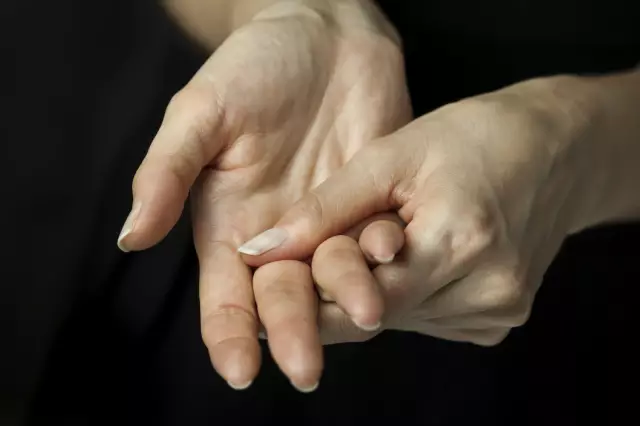- Author Rachel Wainwright [email protected].
- Public 2023-12-15 07:39.
- Last modified 2025-11-02 20:14.
Streptoderma

Streptoderma is a group of skin diseases caused by streptococci. The pathogenic activity of streptococcal bacteria is accompanied by the appearance on the skin of rounded pink spots of irregular shape. The size of streptoderma foci can vary from a few millimeters to several centimeters in diameter. The lesions are localized mainly on the back, face and lower extremities. Streptoderma most often affects children and women.
Forms and varieties of streptoderma
The following types of streptoderma are distinguished: bullous impetigo, streptococcal impetigo (contagious impetigo), slit impetigo (angular stomatitis, jam), impetigo of the nail folds (tournament), lichen simplex.
According to the degree of damage to epithelial tissues, a deep and superficial form of streptoderma is distinguished. The superficial form of streptoderma is called streptococcal impetigo, and the deep form is called ordinary ecthyma. With streptococcal impetigo, purulent vesicles open very quickly, leaving no cosmetic defects.
With ecthyma, the deep layers of the skin are affected. In this case, large ulcerative elements are formed, covered with a dense shell. After the ulcers heal, visible scars remain on the skin. With the diffuse type of streptoderma, extensive areas of the body surface are affected. With the intertriginous type of the disease, purulent foci are localized in the skin folds. The disease affects healthy skin or joins an ongoing inflammatory process.
Causes of streptoderma
Streptoderma is spread from person to person. The incubation period of the disease lasts about a week. The chronic form of the disease can occur in the redistribution of ulcers and wounds that do not heal for a long period of time. The risk of developing streptoderma increases with varicose veins, disruption of local blood circulation, endocrine disorders, diseases of the gastrointestinal tract, as well as with prolonged cooling of the extremities, leading to increased sensitization of the skin, to staphylococcal and streptococcal infections.
An imbalance in skin metabolism plays an important role in the development of the disease. Chronic forms of the disease are often found against the background of renal failure, diabetes mellitus and other chronic pathologies.
Streptoderma symptoms
Subjective sensations with streptoderma are practically absent. Swollen lymph nodes and fever up to subfebrile are common symptoms of streptoderma in children. Some patients complain of dry skin and slight itching of the affected areas.
With slit-like impetigo, shallow linear cracks form after opening the purulent vesicles. They periodically become covered with yellow crusts, which quickly fall off, again revealing cracks in the skin. This form of streptoderma is accompanied by discomfort, burning, itching. Perhaps salivation, pain when eating.
With impetigo of the nail folds, the bubbles are localized on the hands, on the skin in the area of the nail plates. The development of the disease is usually preceded by skin trauma. During the development of streptoderma, the contents of the vesicle changes from serous to purulent. After opening the bubble, an ulcer or erosion forms on the skin, covering the nail fold. Symptoms of this type of streptoderma can be general weakness, fever, swollen lymph nodes, asthenia.
Streptococcal diaper rash most often affects the inner thighs, the area under the mammary glands, the gluteal and groin regions. This disease has a tendency to recurrent or chronic course.

Streptoderma in children is most often manifested as lichen simplex. This disease is rapidly spreading in children's groups. The rise in incidence is observed in spring and autumn. With lichen simplex, the cheeks, legs, and the oral part of the face are usually affected. The development of the disease is accompanied by severe itching of the skin. The symptoms of streptoderma in children diminish or disappear completely after sun exposure.
Streptoderma treatment
For the treatment of streptoderma, in addition to local preparations, general strengthening drugs, vitamin therapy, therapeutic ultraviolet irradiation of the affected skin areas, and ultraviolet blood irradiation (UFOK) are usually prescribed.
For the period of treatment of streptoderma, contact with water should be excluded. Synthetic fabrics and warm clothing can increase perspiration. It is necessary to wear clothes only from natural fabrics and observe the temperature conditions in the room. With this disease, it is very important to adhere to a hypoallergenic diet with the exception of fatty, spicy and sweet.
With streptoderma in children, it is necessary to quarantine contact persons for ten days.
In the lesions, the skin is processed. The pustules and blisters are opened with sterile needles at the base, and then the affected skin is treated with aniline dyes twice a day. After that, a dry aseptic dressing with disinfecting ointments is applied to the affected areas. The crusts are smeared with salicylic petroleum jelly. With a long course of streptoderma, the doctor may prescribe antibacterial drugs.
YouTube video related to the article:
The information is generalized and provided for informational purposes only. At the first sign of illness, see your doctor. Self-medication is hazardous to health!






